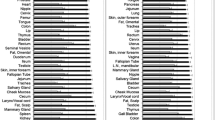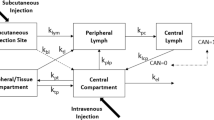Abstract
Our objective was to determine the pharmacokinetics, bioavailability and lymph node uptake of the monoclonal antibody bevacizumab, labeled with the near-infrared (IR) dye 800CW, after intravenous (IV) and subcutaneous (SC) administration in mice. Fluorescence imaging and enzyme-linked immunosorbent assay (ELISA) assays were developed and validated to measure the concentration of bevacizumab in plasma. The bevacizumab–IRDye conjugate remained predominantly intact in plasma and in lymph node homogenate samples over a 24-h period, as determined by sodium dodecyl sulfate polyacrylamide gel electrophoresis and size exclusion chromatography. The plasma concentration vs. time plots obtained by fluorescence and ELISA measurements were similar; however, unlike ELISA, fluorescent imaging was only able to quantitate concentrations for 24 h after administration. At a low dose of 0.45 mg/kg, the plasma clearance of bevacizumab was 6.96 mL/h/kg after IV administration; this clearance is higher than that reported after higher doses. Half-lives of bevacizumab after SC and IV administration were 4.6 and 3.9 days, respectively. After SC administration, bevacizumab–IRDye800CW was present in the axillary lymph nodes that drain the SC site; lymph node uptake of bevacizumab–IRDye 800CW was negligible after IV administration. Bevacizumab exhibited complete bioavailability after SC administration. Using a compartmental pharmacokinetic model, the fraction absorbed through the lymphatics after SC administration was estimated to be about 1%. This is the first report evaluating the use of fluorescent imaging to determine the pharmacokinetics, lymphatic uptake, and bioavailability of a near-infrared dye-labeled antibody conjugate.








Similar content being viewed by others
References
Presta LG, Chen H, O’Connor SJ, Chisholm V, Meng YG, Krummen L, Winkler M, Ferrara N. Humanization of an anti-vascular endothelial growth factor monoclonal antibody for the therapy of solid tumors and other disorders. Cancer Res. 1997;57(20):4593–9.
Ferrara N, Hillan KJ, Gerber HP, Novotny W. Discovery and development of bevacizumab, an anti-VEGF antibody for treating cancer. Nat Rev Drug Discov. 2004;3(5):391–400.
Cohen MH, Gootenberg J, Keegan P, Pazdur R. FDA drug approval summary: bevacizumab (Avastin(R)) plus carboplatin and paclitaxel as first-line treatment of advanced/metastatic recurrent nonsquamous non-small cell lung cancer. Oncologist. 2007;12(6):713–8.
Cohen MH, Shen YL, Keegan P, Pazdur R. FDA drug approval summary: bevacizumab (Avastin) as treatment of recurrent glioblastoma multiforme. Oncologist. 2009;14(11):1131–8.
Wang W, Wang EQ, Balthasar JP. Monoclonal antibody pharmacokinetics and pharmacodynamics. Clin Pharmacol Ther. 2008;84(5):548–58.
Supersaxo A, Hein WR, Steffen H. Effect of molecular weight on the lymphatic absorption of water-soluble compounds following subcutaneous administration. Pharm Res. 1990;7(2):167–9.
Kagan L, Gershkovich P, Mendelman A, Amsili S, Ezov N, Hoffman A. The role of the lymphatic system in subcutaneous absorption of macromolecules in the rat model. Eur J Pharm Biopharm. 2007;67(3):759–65.
Kojima K, Takahashi T, Nakanishi Y. Lymphatic transport of recombinant human tumor necrosis factor in rats. J Pharmacobiodyn. 1988;11(10):700–6.
Chang SK, Rizvi I, Solban N, Hasan T. In vivo optical molecular imaging of vascular endothelial growth factor for monitoring cancer treatment. Clin Cancer Res. 2008;14(13):4146–53.
McLennan DN, Porter CJ, Edwards GA, Brumm M, Martin SW, Charman SA. Pharmacokinetic model to describe the lymphatic absorption of r-metHu-leptin after subcutaneous injection to sheep. Pharm Res. 2003;20(8):1156–62.
Radwanski E, Chakraborty A, Van Wart S, Huhn RD, Cutler DL, Affrime MB, et al. Pharmacokinetics and leukocyte responses of recombinant human interleukin-10. Pharm Res. 1998;15(12):1895–901.
Gearing AJH, Thorpe SJ, Miller K, Mangan M, Varley PG, Dudgeon T, et al. Selective cleavage of human IgG by the matrix metalloproteinases, matrilysin and stromelysin. Immunol Lett. 2002;81(1):41–8. doi:10.1016/S0165-2478(01)00333-9.
Phelps MA, Foraker AB, Gao W, Dalton JT, Swaan PW. A novel rhodamine-riboflavin conjugate probe exhibits distinct fluorescence resonance energy transfer that enables riboflavin trafficking and subcellular localization studies. Mol Pharm. 2004;1(4):257–66.
Wu F, Wuensch SA, Azadniv M, Ebrahimkhani MR, Crispe IN. Galactosylated LDL nanoparticles: a novel targeting delivery system to deliver antigen to macrophages and enhance antigen specific T cell responses. Mol Pharm. 2009;6(5):1506–17.
Xu G, Yong KT, Roy I, Mahajan SD, Ding H, Schwartz SA, et al. Bioconjugated quantum rods as targeted probes for efficient transmigration across an in vitro blood–brain barrier. Bioconjug Chem. 2008;19(6):1179–85.
Yong KT, Ding H, Roy I, Law WC, Bergey EJ, Maitra A, et al. Imaging pancreatic cancer using bioconjugated InP quantum dots. ACS Nano. 2009;3(3):502–10.
Chernomordik V, Hassan M, Lee SB, Zielinski R, Gandjbakhche A, Capala J. Quantitative analysis of Her2 receptor expression in vivo by near-infrared optical imaging. Mol Imaging. 2010;9(4):192–200.
Lee SB, Hassan M, Fisher R, Chertov O, Chernomordik V, Kramer-Marek G, et al. Affibody molecules for in vivo characterization of HER2-positive tumors by near-infrared imaging. Clin Cancer Res. 2008;14(12):3840–9.
Biffi S, Garrovo C, Macor P, Tripodo C, Zorzet S, Secco E, et al. In vivo biodistribution and lifetime analysis of cy5.5-conjugated rituximab in mice bearing lymphoid tumor xenograft using time-domain near-infrared optical imaging. Mol Imaging. 2008;7(6):272–82.
Ding H, Yong KT, Law WC, Roy I, Hu R, Wu F, et al. Non-invasive tumor detection in small animals using novel functional Pluronic nanomicelles conjugated with anti-mesothelin antibody. Nanoscale. 2011;3(4):1813–22.
Zhu J, Yong KT, Roy I, Hu R, Ding H, Zhao L, et al. Additive controlled synthesis of gold nanorods (GNRs) for two-photon luminescence imaging of cancer cells. Nanotechnology. 2010;21(28):285106.
Kopwitthaya A, Yong KT, Hu R, Roy I, Ding H, Vathy LA, et al. Biocompatible PEGylated gold nanorods as colored contrast agents for targeted in vivo cancer applications. Nanotechnology. 2010;21(31):315101.
Licha K, Debus N, Emig-Vollmer S, Hofmann B, Hasbach M, Stibenz D, et al. Optical molecular imaging of lymph nodes using a targeted vascular contrast agent. J Biomed Opt. 2005;10(4):41205.
Lin YS, Nguyen C, Mendoza JL, Escandon E, Fei D, Meng YG, et al. Preclinical pharmacokinetics, interspecies scaling, and tissue distribution of a humanized monoclonal antibody against vascular endothelial growth factor. J Pharmacol Exp Ther. 1999;288(1):371–8.
Shah DK, Veith J, Bernacki RJ, Balthasar JP. Evaluation of combined bevacizumab and intraperitoneal carboplatin or paclitaxel therapy in a mouse model of ovarian cancer. Cancer Chemother Pharmacol. 2011;68(4):951–8.
Bhansali SG, Balu-Iyer SV, Morris ME. Influence of route of administration and liposomal encapsulation on blood and lymph node exposure to the protein VEGF-C156S. J Pharm Sci. 2012;101(2):852–9.
Porter CJ, Charman SA. Lymphatic transport of proteins after subcutaneous administration. J Pharm Sci. 2000;89(3):297–310.
Engeset A. The route of peripheral lymph to the blood stream; an X-ray study of the barrier theory. J Anat. 1959;93(1):96–100.
Kubik S. Anatomy of the lymphatic system. In: Foldi M, Foldi E, Kubik S, editors. Textbook of lymphology. San Francisco: Elsevier GmbH; 2003. p. 1–166.
Wu F, Bhansali SG, Tamhane M, Kumar R, Vathy LA, Ding H, et al. Noninvasive real-time fluorescence imaging of the lymphatic uptake of BSA–IRDye 680 conjugate administered subcutaneously in mice. J Pharm Sci. 2012. doi:10.1002/jps.23058.
Acknowledgments
This work was supported by a grant from the University at Buffalo Center for Protein Therapeutics to MEM. The authors thank Dr. E.J. Bergey and Dr. P.N. Prasad of the Institute for Lasers, Photonics and Biophotonics, University at Buffalo, for use of the Maestro imaging system and their expertise with fluorescence imaging.
Author information
Authors and Affiliations
Corresponding author
Electronic supplementary material
Below is the link to the electronic supplementary material.
ESM 1
(DOCX 12 kb)
Rights and permissions
About this article
Cite this article
Wu, F., Tamhane, M. & Morris, M.E. Pharmacokinetics, Lymph Node Uptake, and Mechanistic PK Model of Near-Infrared Dye-Labeled Bevacizumab After IV and SC Administration in Mice. AAPS J 14, 252–261 (2012). https://doi.org/10.1208/s12248-012-9342-9
Received:
Accepted:
Published:
Issue Date:
DOI: https://doi.org/10.1208/s12248-012-9342-9




